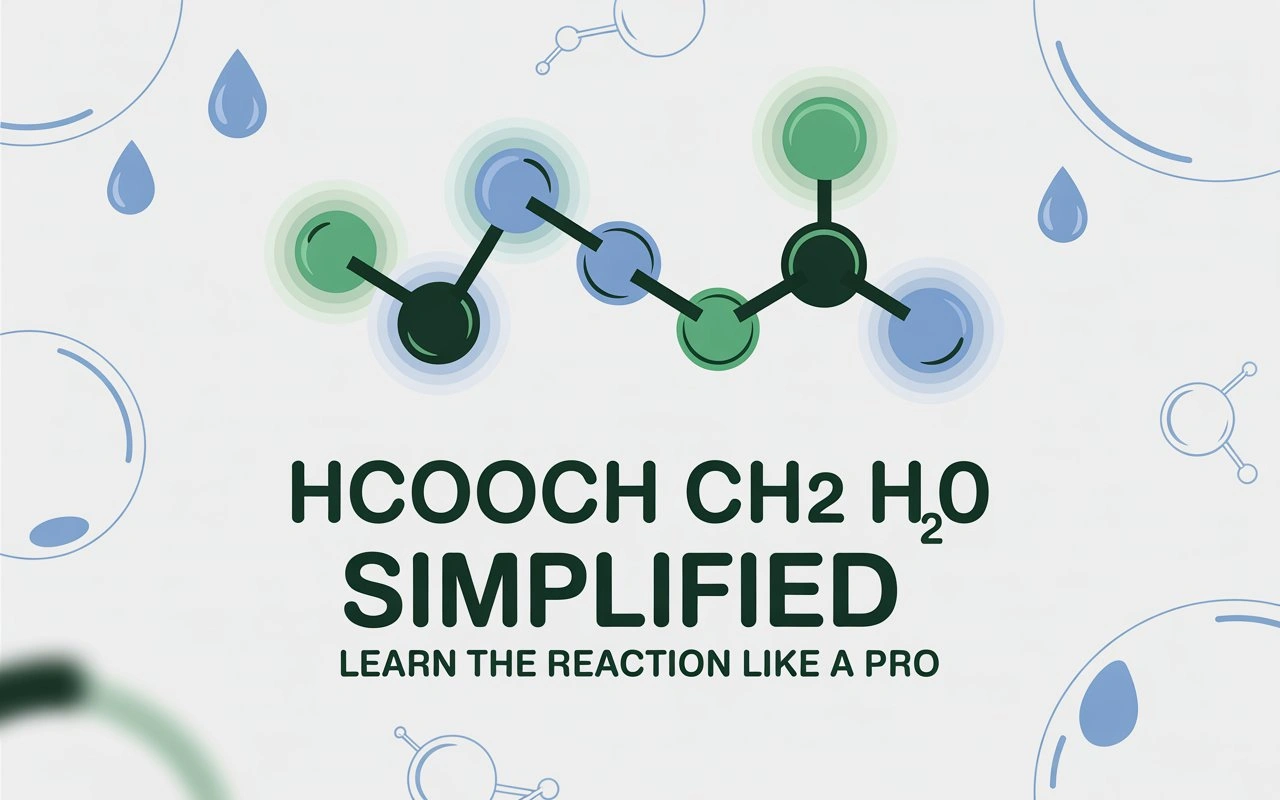Discover the meaning and mechanism of HCOOCH CH2 H2O in organic chemistry. Learn how this reaction works, its applications, and why it matters for students and researchers.
Introduction to the Reaction
In the world of organic chemistry, reactions involving formates, methylene groups, and water play an important role in synthesis and biological systems. The expression HCOOCH + CH2 + H2O may seem intimidating at first, but when broken down step by step, it becomes much easier to understand.
This blog post will simplify the reaction so you can learn it like a pro, whether you’re a chemistry student, researcher, or simply curious about chemical transformations.
Understanding the Chemical Components
What is HCOOCH?
HCOOCH generally represents a formate ester group, derived from formic acid (HCOOH). These esters are widely used in organic synthesis as intermediates in forming other carbon compounds.
What is CH2 in this Context?
The CH2 group is a methylene unit, often used in organic chemistry to represent a building block that connects different carbon atoms. It plays a central role in chain elongation and structural transformations.
What Role Does H2O Play?
H2O (water) acts as a reactant or solvent, depending on the type of reaction. In hydrolysis reactions, water breaks down esters into alcohols and acids, making it a key player here.
Breaking Down the Reaction
Step-by-Step Reaction Mechanism
-
HCOOCH (Formate Ester) interacts with CH2 (methylene group) in the presence of H2O.
-
Water acts as a hydrolyzing agent, breaking the ester bond.
-
The products typically include:
-
Formic acid (HCOOH) or its derivatives
-
Alcohols depending on the attached CH2 structure
-
Possible intermediates for larger organic compounds
-
Reaction Products Explained
The outcome depends on experimental conditions, but the general process leads to simpler, more reactive organic molecules that can be used in further chemical synthesis.
Importance of This Reaction in Organic Chemistry
Applications in Synthetic Chemistry
-
Used in the formation of alcohols and carboxylic acids.
-
Helps in chain elongation of carbon molecules.
-
Often applied in pharmaceutical research to build drug precursors.
Relevance in Biological Systems
Hydrolysis and formate reactions also have biological importance, particularly in metabolic pathways where esters and alcohols are continuously broken down and re-formed.
Real-World Examples and Uses
Industrial Applications
-
Polymer synthesis often relies on such ester-hydrolysis reactions.
-
In green chemistry, formate esters are used as eco-friendly solvents.
Laboratory Experiments
Students often study reactions like this to understand fundamental hydrolysis mechanisms and ester chemistry.
Challenges in Understanding This Reaction
Common Misinterpretations
-
Many confuse HCOOCH as a simple molecule, but it actually represents a functional group.
-
CH2 is not always free—it usually connects larger structures.
Tips to Simplify Learning
-
Break the equation into smaller parts (ester, methylene, and water).
-
Visualize reaction pathways with diagrams.
-
Remember hydrolysis always produces acid + alcohol.
Why This Reaction Matters for Students in 2025
With the rise of green chemistry, pharmaceutical development, and synthetic biology, reactions like HCOOCH + CH2 + H2O are becoming more relevant. Students who master these concepts gain an edge in research and applied chemistry careers.
FAQs About HCOOCH CH2 H2O Reaction
Q1. What does HCOOCH stand for?
It represents a formate ester functional group derived from formic acid.
Q2. What happens when HCOOCH reacts with H2O?
It undergoes hydrolysis, producing formic acid and alcohols.
Q3. Is CH2 always a separate molecule?
Not exactly—CH2 usually connects larger chains in organic compounds.
Q4. Why is this reaction important?
It helps in understanding ester hydrolysis, which has broad applications in synthetic and biological chemistry.
Q5. Can this reaction happen naturally?
Yes, ester hydrolysis occurs both in laboratories and in biological systems like metabolism.
Conclusion
The reaction HCOOCH + CH2 + H2O may look complex, but once simplified, it reflects a classic hydrolysis process central to organic chemistry. By breaking it down step by step, we see how it plays a role in synthetic chemistry, biology, and industrial applications.
For students and researchers, understanding this reaction is a stepping stone to mastering more advanced concepts in organic and applied chemistry.

